Fig.1.
Conceptual comparison of spike-triggered averaging (STA) and electromyogram (EMG)-weighted averaging (EWA). A: STA is typically performed by sorting motor unit spike trains from fine-wire EMG recordings, whereas EWA (B) is performed on a rectified surface EMG signal composed of electrical potentials from many motor units. C: STA typically uses spike trains from individual motor units as a measure of activity, and these spike trains could be combined into a single spike train representing all spikes from all motor units. D: EWA uses rectified surface EMG as a measure of activity, and increases in surface EMG will be correlated with increased activity in the superposed spike train (inset). E: both STA and EWA cross-correlate their activity measure with force fluctuations to produce STA (F) or EWA (G) waveforms. We expect a high degree of similarity between the average STA waveform and the EWA waveform because the surface EMG may be highly correlated with the superposed spike train.

